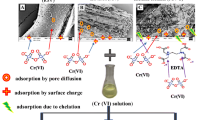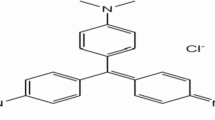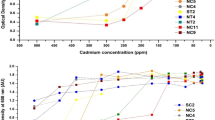Abstract
Waste hazelnut shell was modified using hexadecyltrimethylammonium (HDTMA) to remove tetracycline and cephalexin from water and minimize the residual antimicrobial activity of tetracycline and cephalexin. Response surface methodology (RSM) was used to determine the effect of solution pH (3.0–6.0–9.0), initial pollutant concentration (5–52.5–100 mg/L), contact time (5–92.5–180 min), and temperature (20–35–50°C) on the removal efficiency of tetracycline and cephalexin. Comparison between model results and experimental data gave a high coefficient of determination (R2TC 0.94, R2CPX 0.99). The predicted removal efficiency of tetracycline and cephalexin by the RSM design was 37.34% and 83.07%, respectively. Langmuir, Freundlich, D-R, and Temkin isotherm were applied to equilibrium data. The Qo values for tetracycline and cephalexin were 6.97 and 47.77, respectively. Acute tests were performed before and after biosorption using Lepidium sativum and Daphnia magna. IC50, LC50, and toxic unit were determined. IC50 values for root and shoot for tetracycline and cephalexin were 50 mg/L, 50 mg/L, 140 mg/L, and 270 mg/L, respectively. LC50 values of tetracycline and cephalexin were 58 mg/L and 37 mg/L for 48 h, respectively. There was a large decrease in mortality (%) after biosorption. This biosorbent was effective in the biosorption of tetracycline and cephalexin and in reducing toxicity.






Similar content being viewed by others
Data Availability
All data generated or analysed during this study are included in this published article (and its supplementary information files).
References
Abutaleb, A., Tayeb, A. M., Mahmoud, M. A., Daher, A. M., Desouky, O. A., Bakather, O. Y., & Farouq, R. (2020). Removal and recovery of U(VI) from aqueous effluents by flax fiber: Adsorption, desorption and batch adsorber proposal. J Advanced Research, 22, 153–162. https://doi.org/10.1016/j.jare.2019.10.011
Açıkel, Ü., Erşan, M., & Açıkel, Y. S. (2010). Optimization of critical medium components using response surface methodology for lipase production by Rhizopus delemar. Food Bioproducts Processing, 88(1), 31–39.
Al-Yousef, H. A., Alotaibi, B. M., Aouaini, F., Sellaoui, L., & Bonilla-Petriciolet, A. (2021). Adsorption of ibuprofen on cocoa shell biomass-based adsorbents: Interpretation of the adsorption equilibrium via statistical physics theory. Journal of Molecular Liquids, 331, 115697.
Aslan, S., & Şirazi, M. (2020). Adsorption of sulfonamide antibiotic onto activated carbon prepared from an agro-industrial by-product as low-cost adsorbent: Equilibrium, thermodynamic, and kinetic studies. Water Air Soil Pollution, 231, 222. https://doi.org/10.1007/s11270-020-04576-0
Bangari, R. S., & Sinha, N. (2019). Adsorption of tetracycline, ofloxacin and cephalexin antibiotics on boron nitride nanosheets from aqueous solution. Journal of Molecular Liquids, 293, 111376.
Brain, R. A., Hanson, M. L., Solomon, K. R., & Brooks, B. W. (2008). Aquatic plants exposed to pharmaceuticals: Effects and risks. Reviews of Environmental Contamination and Toxicology, 192, 67–115.
Boonsaner, M., & Hawker, D. W. (2012). Investigation of the mechanism of uptake and accumulation of zwitterionic tetracyclines by rice (Oryza sativa L.). Ecotoxicology and Environmental Safety, 78, 142–147. https://doi.org/10.1016/j.ecoenv.2011.11.023
Bougdah, N., Messikh, N., Bousba, S., Djazi, F., Magri, P., & Rogalski, M. (2020). Removal of chlorobenzene by adsorption from aqueous solutions on the HDTMA-bentonites as a function of HDTMA/CEC ratio. Current Research in Green Sustainable Chemistry, 3, 100038.
Bownik, A. (2019). Physiological endpoints in daphnid acute toxicity tests. The Science of the Total Environment, 134400. https://doi.org/10.1016/j.scitotenv.2019.134400
Cataldo, S., Gianguzza, A., Milea, D., Muratore, N., Pettignano, A., & Sammartano, S. (2018). A critical approach to the toxic metalion removal by hazelnut and almond shells. Environmental Science and Pollution Research International, 25, 4238–4253. https://doi.org/10.1007/s11356-017-0779-3
Chabani, M., Amrane, A., & Bensmail, A. (2006). Kinetic modelling of the adsorption of nitrates by ion exchange resin. Chemical Engineering Journal, 125, 111–117.
Charuaud, L., Jarde, E., Jaffrezic, A., Thomas, M. F., & Le Bot, B. (2019). Veterinary pharmaceutical residues from natural water to tap water: Sales, occurrence and fate. Journal of Hazardous Materials, 361, 169–186. https://doi.org/10.1016/j.jhazmat.2018.08.075
Chen, M., Wang, X., & Zhang, H. (2021). Comparative research on selective adsorption of Pb(II) by biosorbents prepared by two kinds of modifying waste biomass: Highly-efficient performance, application and mechanism. Journal of Environmental Management, 288, 112388.
Cimino, G., Passerini, A., & Toscano, G. (2000). Removal of toxiccations and Cr(VI) from aqueous solution by hazelnut shell. Water Research, 34, 2955–2962. https://doi.org/10.1016/S0043-1354(00)00048-8
EC (1996). Commission of the European Communities: Technical Guidance Document in Support of Commission Directive 93/67/EEC on Risk Assessment for Existing Substances, Part II-Environmental Risk Assessment (Brussels, Belgium).
Erşan, M., & Açıkel, Ü. (2014). Optimization of acid phosphates production and Zn(II) bioaccumulation by R. delemar using response surface method. Journal of the Faculty of Engineering and Architecture of Gazi University, 29(2), 321–329. https://doi.org/10.17341/gummfd.95280
Gangil, M., & Pradhan, M. K. (2017). Modeling and optimization of electrical discharge machining process using RSM: A review. Material Today Proceedings, 4, 1752–1761. https://doi.org/10.1016/j.matpr.2017.02.017
Gil, A., Taoufik, N., García, A. M., & Korili, S. A. (2019). Comparative removal of emerging contaminants from aqueous solution by adsorption on an activated carbon. Environmental Technology, 40, 3017–3030. https://doi.org/10.1080/09593330.2018.1464066
Grenni, P., Ancona, V., & Caracciolo, A. B. (2018). Ecological effects of antibiotics on natural ecosystems: A review. Microchemical Journal, 136, 25–39.
Hajkova, M., Kummerova, M., Zezulka, S., Babula, P., & Vaczi, P. (2019). Diclofenac as an environmental threat: impact on the photosynthetic processes of Lemna minor chloroplasts. Chemosphere, 224, 892–899. https://doi.org/10.1016/j.chemosphere.2019.02.197
Hiew, B. Y. Z., Lee, L. Y., Lee, X. J., Gan, S., Thangalazhy-Gopakumar, S., Lim, S. S., Pan, G. T., & Yang, T. C. K. (2019). Adsorptive removal of diclofenac by graphene oxide: Optimization, equilibrium, kinetic and thermodynamic studies. Journal of the Taiwan Institute of Chemical Engineers, 98, 150–162.
Huo, B., Meng, F., Yang, J., Wang, Y., Qi, J., Ma, W., Wang, Z., Wang, J., & Wang, Z. (2022). High efficiently piezocatalysis degradation of tetracycline by few-layered MoS2/GDY: mechanism and toxicity evaluation. Chemical Engineering Journal, 436, 135173.
Ian, C., & Marilyn, R. (2001). Tetracycline antibiotics: mode of action, applications, molecular biology, and epidemiology of bacterial resistance. Microbiology and Molecular Biology Reviews, 65, 232–260. https://doi.org/10.1128/MMBR.65.2.232
Karnjanakom, S., & Maneechakr, P. (2019). Adsorption behaviors and capacities of Cr(VI) onto environmentally activated carbon modified by cationic (HDTMA and DDAB) surfactants. Journal of Molecular Structure, 1186, 80–90.
Karri, R. R., Sahu, J. N., & Meikap, B. C. (2020). Improving efficacy of Cr (VI) adsorption process on sustainable adsorbent derived from waste biomass (sugarcane bagasse) with help of ant colony optimization. Industrial Crops and Products, 143, 111927.
Khandaker, S., Toyohara, Y., Saha, G. C., Awual, M. R., & Kuba, T. (2020). Development of synthetic zeolites from bio-slag for cesium adsorption: kinetic, isotherm and thermodynamic studies. Journal of Water Process Engineering, 33, 101055. https://doi.org/10.1016/j.jwpe.2019.101055
Krewski, D., Andersen, M. E., Tyshenko, M. G., Krishnan, K., Hartung, T., Boekelheide, K., Wambaugh, J. F., Jones, D., Whelan, M., Thomas, R., Yauk, C., Barton Maclaren, T., & Cote, I. (2020). Toxicity testing in the 21st century: progress in the past decade and future perspectives. Archieves of Toxicology, 94(1), 1–58. https://doi.org/10.1007/s00204-019-02613-4
Legnoverde, M. S., Simonetti, S., & Basaldella, E. I. (2014). Influence of pH on cephalexin adsorption onto SBA-15 mesoporous silica: Theoretical and experimental study. Applied Surface Science, 300, 37–42.
Lin, A. Y. C., Yu, T. H., & Lateef, S. K. (2009). Removal of pharmaceuticals in secondary wastewater treatment processes in Taiwan. Journal of Hazardous Materials, 167, 1163–1169.
Lv, G., Li, Z., Elliott, L., Schmidt, M. J., Mac Williams, P. M., & Zhang, B. (2019). Impact of tetracycline-clay interactions on bacterial growth. Journal of Hazardous Materials, 370, 91–97.
Mate, C. J., & Mishra, S. (2020). Synthesis of borax cross-linked Jhingan gum hydrogel for remediation of Remazol Brilliant Blue R (RBBR) dye from water: Adsorption isotherm, kinetic, thermodynamic and biodegradation studies. International Journal of Biological Macromolecules, 151, 677–690. https://doi.org/10.1016/j.ijbiomac.2020.02.192
Mehrasbi, M. R., Farahmandkia, Z., Taghibeigloo, B., & Taromi, A. (2009). Adsorption of lead and cadmium from aqueous solution by using almond shells. Water Air Soil Pollution, 199, 343–351. https://doi.org/10.1007/s11270-008-9883-9
Mohammadi, S., Shirmohammadi, R., Pakan, M., Ghasempour, R., & Alighardashi, A. (2022). Optimization of a three-dimensional electrochemical process with granular activated carbon for diclofenac removal using response surface methodology. Environmental Progress and Sustainable Energy, 41(1), e13715.
Mosa, A., El-Ghamry, A., & Tolba, M. (2020). Biochar-supported natural zeolite composite for recovery and reuse of aqueous phosphate and humate: Batch sorption-desorption and bioassay investigations. Environmental Technology & Innovation, 19, 100807.
Mosaleheh, N., & Sarvi, M. N. (2020). Minimizing the residual antimicrobial activity of tetracycline after adsorption into the montmorillonite: Effect of organic modification. Environmental Research, 182, 109056.
Paunovic, O., Pap, S., Maletic, S., Taggart, M. A., Boskovic, N., & Sekulic, M. T. (2019). Ionisable emerging pharmaceutical adsorption onto microwave functionalised biochar derived from novel lignocellulosic waste biomass. Journal of Colloids Interface Science, 547, 350–360.
Pouretedal, H. R., & Sadegh, N. (2014). Effective removal of amoxicillin cephalexin tetracycline and penicillin G from aqueous solutions using activated carbon nanoparticles prepared from vine wood. Journal of Water Process Engineering, 1, 64–73.
Priyan, V. V., Shahnaz, T., Suganya, E., Sivaprakasam, S., & Narayanasamy, S. (2021). Ecotoxicological assessment of micropollutant diclofenac biosorption on magnetic sawdust: Phyto microbial and fish toxicity studies. Journal of Hazardous Materials, 403, 123532.
Riaz, L., Mahmood, T., Yang, Q., Yasir, M. W., Rashid, A., Coyne, M. S., & D’angelo, E. (2019). Sorption and desorption behavior of fluoroquinolone antibiotics in an agricultural soil. Pedosphere, 29(5), 676–680.
Rodrigues, S., Antunes, S. C., Correia, A. T., Golovko, O., Zlabek, V., & Nunes, B. (2019). Assessment of toxic effects of the antibiotic erythromycin on the marine fish gilthead seabream (Sparus aurata L) by a multi–biomarker approach. Chemosphere, 216, 234–247.
Safari, M., Abdi, R., Adl, M., & Kafashan, J. (2018). Optimization of biogas productivity in labscale by response surface methodology. Renewable Energy, 118, 368–375.
Shams, M., Goharshadi, E. K., Ghaleh Askari, S., Tavakkoli Nezhad, N., Aziznezhad, M., Derakhshan Nejad, Z., & Wilson, L. D. (2021). Parameter optimization of tetracycline removal by vanadium oxide nano cuboids. Colloids and Surfaces A: Physicochemical and Engineering Aspects, 619, 126460.
Sürmen, Y. (2003). The necessity of biomass energy for the Turkish economy. Energ Source, 25(2), 83–92.
Tkaczyk, A., Bownik. A., Dudka. J., Kowal, K.., & Ślask, B. (2021). Daphnia manga model in the toxicity assessment of pharmaceuticals: A review. Science of the Total Environment, 763, 143038.
Taoufik, N., Elmchaouri, A., El Mahmoudi, S., Korili, S. A., & Gil, A. (2021). Comparative analysis study by response surface methodology and artificial neural network on salicylic acid adsorption optimization using activated carbon. Environmental NanotechnologyMonitoring Management, 15, 100448.
Tomul, F., Arslan, Y., Basoglu, F. T., Babuçcuoglu, Y., & Tran, H. N. (2019). Efficient removal of anti-inflammatory from solution by Fe-containing activated carbon: adsorption kinetics isotherms and thermodynamics. Journal of Environmental Management, 238, 296–306. https://doi.org/10.1016/jjenvman201902088
Tongur, S., & Yıldırım, R. (2015). Acute toxicity assessment of antibiotics in water by Luminiscence Bacteria and Lepidium Sativum. Procedia Earth Planet Science, 15, 468–473.
Topal, M., & Arslan Topal, E. I. (2020). Optimization of tetracycline removal with chitosan obtained from mussel shells using RSM. Industrial & Engineering Chemistry Research, 84, 315–321.
Vilardi, G., Bubbico, R., Palma, L. D., & Verdone, N. (2020). Nitrate green removal by fixed-bed columns packed with waste biomass: Modelling and friction parameter estimation. Chemical Engineering Research and Design, 154, 250–261.
Wang, H. Z., Luo, Y., Xu, W. Q., Zhou, Q. X., Tang, B. H., & Wang, Y. Y. (2008). Ecotoxicity effects of tetracycline and chlortetracycline on aquatic organisms. Journal of Agro-Environment Science, 27, 1536–1539.
Watkinson, A. J., Murby, E. J., Kolpin, D. W., & Costanzo, S. D. (2009). The occurrence of antibiotics in an urban watershed: From wastewater to drinking water. Science of Total Environment, 407, 2711–2723.
Wollenberger, L., Halling Sorensen, B., & Kusk, K. O. (2000). Acute and chronic toxicity of veterinary antibiotics to Daphnia manga. Chemosphere, 40, 723–730.
Wu, H., Xie, H., He, G., Guan, Y., & Zhang, Y. (2016). Effects of the pH and anions on the adsorption of tetracycline on iron-montmorillonite. Applied Clay Science, 119, 161–169.
Xiang, Y., Xu, Z., Wei, Y., Zhou, Y., Yang, X., Yang, Y., et al. (2019). Carbon-based materials as adsorbent for antibiotics removal: Mechanisms and influencing factors. Journal of Environmental Management, 237, 128–138.
Xu, R., Wu, Z., Zhou, Z., & Meng, F. (2019). Removal of sulfadiazine and tetracycline in membrane bioreactors: Linking pathway to microbial community shift. Environmental Technology, 40(2), 134–143.
Zhang, H., Bian, J., Yang, C., Hu, Z., Liu, F., & Zhang, C. (2022). Removal of tetracycline from livestock wastewater by positive single pulse current electrocoagulation: Mechanism, toxicity assessment and cost evaluation. Science of the Total Environment, 810, 151955.
Zhang, L., Wang, Y., Jin, S. W., Lu, Q. Z., & Ji, J. (2017). Adsorption isotherm, kinetic and mechanism of expanded graphite for sulfadiazine antibiotics removal from aqueous solutions. Environmental Technology, 38(20), 2629–2638.
Zhang, Y., Price, G. W., Jamieson, R., Burton, D., & Khosravi, K. (2017a). Sorption and desorption of selected non-steroidal anti-inflammatory drugs in an agricultural loam-textured soi.l. Chemosphere, 174, 628–637.
Zhang, B., Han, X., Gu, P., Fang, S., & Bai, J. (2017b). Response surface methodology approach for optimization of ciprofloxacin adsorption using activated carbon derived from the residue of desilicated rice husk. Journal of Molecular Liquids, 238, 316–325. https://doi.org/10.1016/jmolliq201704022
Zhao, Y., Zhao, H., Zhao, X., Qu, Y., & Liu, D. (2020). Synergistic effect of electrostatic and coordination interactions for adsorption removal of cephalexin from water using a zirconium-based metal-organic framework. Journal of Colloids Interface Science, 580, 256–263.
Acknowledgements
The authors are thankful to Mehtap Ersan for advice on this article improvement and RSM analysis.
Author information
Authors and Affiliations
Contributions
Guler, U.A.: thesis advisor (conceptualization, funding acquisition, investigation, methodology, project administration, resources, software, supervision, validation, visualization, original draft, writing, review & editing); Solmaz, B.: master thesis (investigation; data curation, formal analysis)
Corresponding author
Ethics declarations
Ethics Approval and Consent to Participate
Not applicable.
Consent for Publication
Not applicable.
Competing İnterests
The authors declare no competing interests.
Additional information
Publisher’s Note
Springer Nature remains neutral with regard to jurisdictional claims in published maps and institutional affiliations.
Supplementary Information
ESM 1
(DOCX 145 kb)
Rights and permissions
About this article
Cite this article
Guler, U.A., Solmaz, B. Biosorption of Tetracycline and Cephalexin onto Surfactant-Modified Waste Biomass Using Response Surface Methodology and Ecotoxicological Assessment: Phytotoxicity and Biotoxicity Studies. Water Air Soil Pollut 233, 117 (2022). https://doi.org/10.1007/s11270-022-05590-0
Received:
Accepted:
Published:
DOI: https://doi.org/10.1007/s11270-022-05590-0




